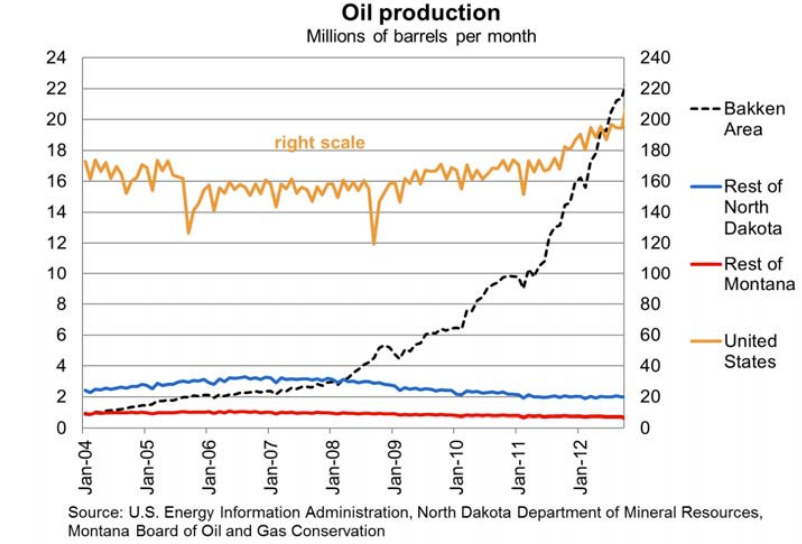The Bakken shale oil formation in North Dakota and Montana is making that area boom economically, at least according to the Federal Reserve Bank of Minneapolis, who recently compiled statistics relating to oil production, jobs, and banking trends in the area.[i] Against the backdrop of stagnant national employment, wages and economic growth, the Bakken and other areas where oil and gas development are creating new wealth should be a “teachable moment” for federal policymakers. According to the data, the area’s oil boom is four times greater than the oil boom in the 1980s. The bank’s new report shows:
- Bakken oil production accounts for 11 percent of total U.S. oil production.
- Monthly oil production increased by 16 percent (3.1 million barrels) between May and October, 2012. (See chart below.)
- The oil production increase in the Bakken represented 40 percent of the increased oil production nationwide.
- The unemployment rate is 1.8 percent in the Bakken area compared to 3.5 percent in rest of North Dakota, 6.4 percent in the rest of Montana, and 7.8 percent nationwide.
- Average weekly wages increased 19 percent in the Bakken area during the 4-quarter period ending in the first quarter of 2012, compared to a 4 percent growth in the rest of North Dakota, 1.9 percent growth in Montana, and basically no growth nationwide during that one-year period. (See chart below.)
- New businesses have grown by almost 50 percent in the Bakken area since 2009, compared to 5 percent growth for the rest of North Dakota and 3 percent growth in the United States.
- The value of taxable sales and purchases in North Dakota more than doubled in the past 5 years, averaging an annual growth of over 14 percent, with most of the increase coming from the mining and oil sector.
- Per capita household income in the Bakken area is above that in the rest of Montana, North Dakota, and the nation based on data through 2011. In fact, workers in the Bakken make about $200 more per week than the average wage for the United States. The poverty rate is dropping faster in the Bakken than in the rest of Montana and North Dakota, as well as in the United States where it has increased since 2007, but remained steady last year at 15 percent.[ii]
- Construction and land development loans in the Bakken area increased 64 percent, from $107 million to $176 million between March 31 and September 30, 2012, which compares to a 12 percent increase for the rest of North Dakota and a 2 percent decrease in the rest of Montana.[iii]
The analysis is based on data from the North Dakota Department of Mineral Resources, which is forecasting that oil industry jobs will continue to grow over the next five years, exceeding 60,000 with the jobs shifting from drilling and hydraulic fracturing to production and other permanent jobs.
Source: http://www.minneapolisfed.org/publications_papers/fedgazette/oil/bakken_fullactivity_Jan3-2013.pdf
Source: http://www.minneapolisfed.org/publications_papers/fedgazette/oil/bakken_fullactivity_Jan3-2013.pdf
The Bakken development should be an example for the nation, indicating what could be accomplished with the right energy policies to decrease unemployment, raise government revenues, increase per capita income, decrease poverty, and help produce the nation’s major energy source.
So far, the hydraulic fracturing revolution that has created these positive economic developments is largely confined to production on private and state lands, due to governmental policies reducing opportunities on federal lands and a punitive federal regulatory environment. Even though there are massive shale oil and oil shale resources on federal lands, federal policies are choking off any production increases. Here’s one illustrious example: it takes the federal government 307 days to process a permit to drill, but it only takes North Dakota 10 days.
North Dakota is a shining example of the potential to grow the economy through energy development. The question is whether the federal government will follow North Dakota’s lead and work to create jobs or if it will continue to restrict access and choke off a major source of economic growth. So far, the federal government’s record is very poor.
[i] Federal Reserve Bank of Minneapolis, The Bakken Oil Boom, http://www.minneapolisfed.org/publications_papers/fedgazette/oil/index.cfm
[ii] Washington Times, Poverty rate doesn’t rise in 2012, September 12, 2012, http://www.washingtontimes.com/news/2012/sep/12/poverty-rate-doesnt-rise-in-2012-median-household-/
[iii] Federal Reserve Bank of Minneapolis, Highlights of Recent Trends in the Bakken, December 20, 2012, http://www.minneapolisfed.org/publications_papers/fedgazette/oil/bakken_trends_Jan3-2013.pdf and http://www.minneapolisfed.org/publications_papers/fedgazette/oil/bakken_fullactivity_Jan3-2013.pdf
